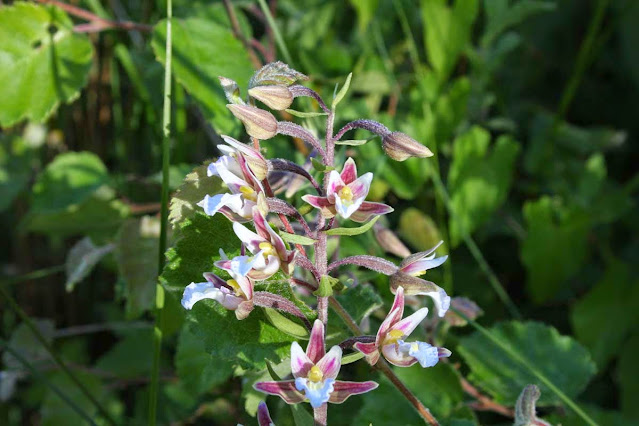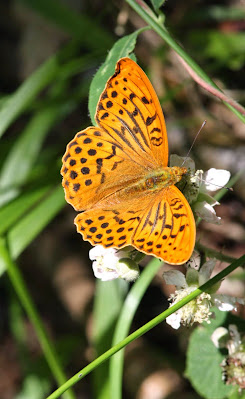Sunday morning and the rain and cloud of yesterday had been replaced by milder and sunnier weather this morning. I wake early these days so was out of bed and on the road by 7.30 am making my way to Dry Sandford Pit, a BBOWT reserve a few miles south of Oxford that I had never visited before.
After a minor problem with the directions I found myself driving into the tiny and well hidden car park that served the reserve. Leaving the car I entered the reserve through a small gate. Some of the reserve is wooded but there is an area of fen that I was looking for as it harbours hundreds of Marsh Helleborines, a plant I had not seen before. It was only a few hundred metres when I came across the small area of fen and made my way somewhat precariously into the heart of the fen following an obvious track.
Marsh Helleborines were everywhere I looked and well worth my coming to see. A medium height plant of such delicate beauty with waxy white flowers coloured deep pink, almost mauve on the inside of the petals, the individual flowers growing in profusion up the flower stalk.
Marsh Helleborines
|
The reserve like many BBOWT reserves is a small understated gem. The kind of place that you feel is almost a well kept secret but once known you feel better for being aware of its existence. I sat on a bench overlooking the fen and just enjoyed the sunshine and the profusion of helleborines and orchids growing below me in the boggy fen. A buddleia opposite me was in full bloom and its sweet scent perfumed the early morning air and the profusion of flower spikes, heavy and purple had attracted a family of Blue Tits as well as a few ChiffChaffs, presumably finding many insects lured to the flower spikes by the honeyed scent. A male Blackcap warbled loudly, his grey throat swelling as he sang and his grey underparts turning almost silver in the morning sunlight. I sat for a while in contemplation and quiet contentment. A Red Admiral, all bright primary colours, settled on a hazel leaf, its garish appearance almost crude compared to the delicate beauty I had just encountered with the helleborines.
Marbled Whites and Meadow Browns jigged their random paths across the fen and a Small Skipper absorbed the sun's energy as it perched on a dead stem.
One knows the time to move on and for me it came with the first dog walker. The spell was broken but for an hour I had enjoyed this quiet corner, hopefully preserved forever by the excellent work done by the many volunteers who clear the scrub each year to preserve the fen and thereby the helleborines and orchids and all the other delicate life forms that rely on the reserve's existence.
I moved on. Back briefly onto busy roads around Oxford before finding leafy sanctuary in Bernwood Forest. I love this place, the quiet of the woods on either side of the wide track running through it is soothing and gives a sense of permanence and peace. I walked slowly along its mile and a half length but today there were no Purple Emperors, possibly because it was a little early in the year although I had seen one here, albeit briefly, earlier in the week. However that other gem of these woods, the Silver Washed Fritillary was now well on the wing.
Silver washed Fritillaries
|
Huge, powering along in a fast swooping and swerving flight along the woodland edge and through the glades, their bright ginger forms passed me at great speed on their unknown quest. Occasionally one landed on a bramble to feed, almost orange in the strong sunlight as it fed on the pink tinged white flowers. A brief flicker higher up in an oak brought my attention to another fast flier and restless examiner of the woods. A White Admiral. It settled briefly on a leaf and then was gone into the depths of the wood. I wandered back to the car and made for my last stop.
Parsonage Moor, another BBOWT Reserve and yet another little gem of a reserve is not far from Dry Sandford Pit. I walked along the boardwalk through the reeds and came to a runnel, a narrow channel of sluggish flowing water with boggy margins and sure enough there was a male Keeled Skimmer as there always is. His slim, powder blue body borne on gauze like wings. He flew towards me as if in examination of my presence and then returned low over the barely discernible trickling waters to settle on the vegetation, turning his wings to the sun.
Male Keeled Skimmer
|
Southern Damselflies teetered as if constantly unsure of themselves over the marshy ground and water, some in mating pairs, others single and unattached. Their delicate beauty mirrored the fragile habitat that but for the voluntary work carried on here every year would be unable to sustain them.
Southern Damselflies mating
|
Male Southern Damselfly
|
I wandered further along a grassy track surrounded by reeds and marsh thistles. An exotic combination of red, black and cream caught my eye resting like a jewel in the grass at the base of the reeds. It was a moth, its brightness exotic and unexpected amongst the more mundane green surroundings It was a Scarlet Tiger and as it took off to wing its way up into a willow the red underwings shone, startling in their brightness.
Scarlet Tiger
|
That was my day done. Simple pleasures are sometimes the best.


































































